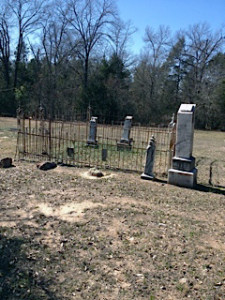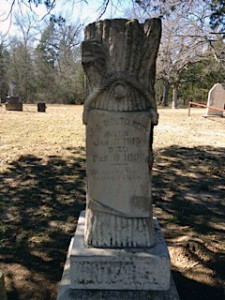Cultural differences found throughout the various ethnic groups extend to death rituals and cemetery customs. In the north Texas area, many of the cemetery customs have roots that transcend Anglo, African-American and Southeastern Amerindian cultures. A trip to any cemetery in the region will reveal many of these cultural traits.
The hearse and mourners entered through an arched gateway, formally known as a lichgate. An open-sided shelter or tabernacle was used for the funeral service in earlier times. The cemetery usually sat on high ground. Throughout the cemetery were found rosebushes, iris, lilies, crape myrtles, nandinas and hollies. Large cedar or juniper trees shaded the grounds. Benches were often found near graves to allow family members to commune with the deceased. My great-grandfather, Jefferson Seay, had a wrought iron bench placed beside his wife’s grave. Every Sunday afternoon he would ride his horse over to the Belcherville cemetery in Montague County to sit by her grave.
Most of the early settlers in this area were from the upland South, Georgia, Alabama, Mississippi, Tennessee and Arkansas. Their graves and customs followed one in the old states. Graves dug beneath the ground with an east-west orientation were the norm in order for the deceased to rise from the grave facing Jerusalem. An occasional north-south orientation indicated someone needed eternal punishment, such as a horse-thief or swindler.
Until the mid-twentieth century graves were scraped or hoed to keep the grass from growing. Some were even decorated with raked patterns. If a farmer spent his entire life chopping weeds in his cotton field, his children weren’t about to let grass grow on his grave; but a more practical reason was to keep cows and horses from grazing on the grave. Special days were set aside to clean the graves. Decoration Day was usually held in May. A mid-day meal served by the women culminated the work. Today the custom continues in small, rural areas with cemetery association business the order of the day.
Families are a very important part of Southern tradition. It is only logical that family groups were buried together in Southern cemeteries. Often a low fence or curb surrounded the family plot. The wife was interred on the south or right side of her husband.
Graves decorated with shells, pieces of glass or pottery, or Christmas decorations are still in vogue. By the early part of the twentieth century, it was fashionable to cover graves with a piece of molded cement with the tombstone inscription inlaid.
Tombstones seldom contain a cross. Earliest grave markers in this area were made of bois d’arc stumps or blocks. If stones could be found, these were used. During the Depression, home made cement stones were often fashioned by the bereaved family. In the latter part of the nineteenth century, some graves were marked with bricks. These bricks came from dismantled chimney when cast-iron stoves replaced open fireplaces.
The most common stone for men was one from the Woodsmen of the World. This fraternal organization provided a life insurance policy that included one of their tombstones. These often resembled a tree, or in some cases, a rick of sawed logs.
Tombstones of the period contained a lamb or dove for small children. Rosebuds and roses adorned the tombstones of young girls. The Eye of God enclosed in a triangle symbolized the omnipresence of God. Many tombstones contained hands. An index finger pointing upwards indicated the hope of heaven. A hand holding a heart was a symbol of the Oddfellows Lodge. Clasped hands symbolized friendship.
Surviving family members in the days of the Texas frontier did burials. There was little delay between the death and the burial. Embalming techniques were not developed in the US until the Civil War period.
In 1861 an event occurred in England that would change the funerary practices on both sides of the North Atlantic. Prince Albert consort of Queen Victoria died suddenly in December. The ruler of the British Empire was devastated. She ordered the entire court into deep mourning for more than a year. Victoria, herself, went into seclusion for five years and remained in deep mourning for the remainder of her life.
Thus, the rigid mourning customs of the late nineteenth and early twentieth century began. Some of the more common ones included hair and jet jewelry. Brooches were woven from locks of the deceased hair. Jewelers added pins and other gold touches
Jet was lightweight, easy to carve and black, the color of mourning and was used in brooches.
Coffin photographs, especially of young children, were distributed at the funeral. Memorial cards invited mourners to the funeral. If you received one, you had to attend or risk hurting the family’s tender feelings. If you did not receive one, you felt terribly slighted.
Lengthy obituaries were a sign of the Victorian mourning customs. These are often found in the old newspapers. The music and flowers were described in minute details as was the good and chivalrous character of the deceased. Don’t expect to find much about the wife or children, though.
In fact, women seldom attended their husband’s funeral. The funerals were held at home where the widow and her friends stayed upstairs during the service. Both men and women attended funerals for children and women.
The family wore mourning clothes for at least one year. Anyone attending a funeral must be properly attired in his or her finest funeral garments. Josephine Tennessee Sampley was considered the black sheep of her family, not because she married five times, and divorced one the men, but because she wore a mauve sash around her waist to a funeral. How shocking!



